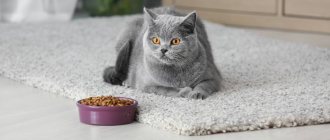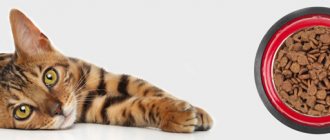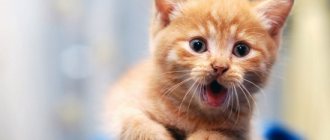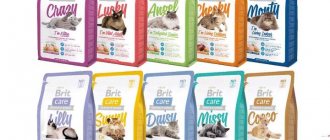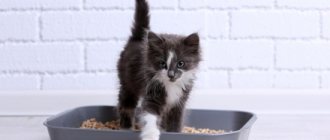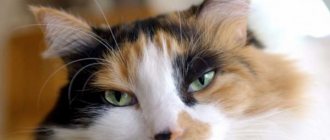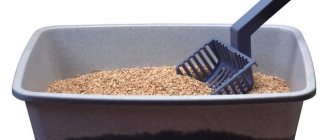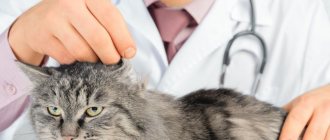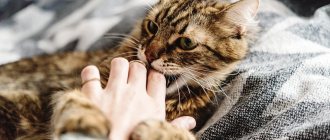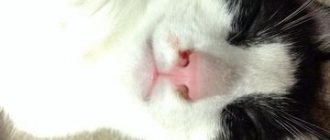A furry little friend in the house is a great joy for the whole family. Cats are the most unpretentious animals to care for and feed. But, unfortunately, modern life forces us to provide care in faster and simpler ways, especially in terms of food.
More and more often, people are buying dry food, which seems to be an excellent replacement for normal food. But sometimes some problems arise. Almost every owner at least once in the entire life of a cat is faced with the fact that the cat refuses to eat. Let's consider a situation when a cat or kitten does not eat dry food, what to do in this case. In addition, you should understand which foods are beneficial and which are harmful.
The cat was given a try for the first time
It often happens that the cat’s owners have given fish, meat, cheese, poultry, and sour cream since childhood. But now we decided to buy dry food. And suddenly the animal refused. In this case, it is better to return to the previous diet so that the cat does not develop an upset stomach or intestinal problems.
Another situation is when the kitten does not eat dry food. What to do? There are two options here:
- Keep the same diet as it was (if he has already tried solid food).
- Buy other food (dry and wet).
In any case, you need to watch how the baby behaves. You can offer a variety of dishes, but do not overdo it, for example, sour cream, fish, poultry, dry food from different manufacturers.
Just do this not immediately, in very small pieces/portions, for example the size of a pea. Don't interrupt your kitten's appetite. For example, treat him with sour cream or a piece of cheese in the morning, and offer dry food or pate for lunch (of course, if he doesn’t eat anything offered). But if, for example, a cat recognizes sour cream as a good food, then it is better to give it about 1 tablespoon every morning.
Backup options
It is important to open the briquette with food right in front of the cat. Most animals will be attracted to this and will gobble up the food with interest. There is another interesting method - feeding the cat from your finger. The fact is that many cats will never touch the food in the bowl. They will lick this same food off their finger with great pleasure. Let’s assume that the animal simply didn’t taste the food. But finger feeding will help you quickly get used to the food in his bowl. It is even possible to slightly open his mouth so that he can quickly feel the taste of food. If the kitten does not eat dry food, you now know what to do.
The one who always ate does not eat
It is not surprising if a cat refuses to eat dry food, which he always ate with pleasure. This happens often, but it does not mean that something happened to the animal. Perhaps I'm just tired of the smell and taste. It's time to find a worthy replacement for your usual food. You don’t have to look for an analogue; you can try a completely different type of nutrition. Let’s say if you constantly used dry food “Friscas with vegetables”, then what’s stopping you from offering a piece of liver or chicken fillet? It is possible that the cat will be delighted with such a treat.
The same applies to kittens. You need to try everything, but do not overfeed with different foods. This is necessary in order to understand what the animal’s preferences are: natural food or food industry products.
The cat is tired of the taste or consistency
Cats, like people, get tired of the same food over time. If your pet eats the same food for a long time, he may simply get bored with it and want variety. If your four-legged pet suddenly begins to refuse his usual food, perhaps it’s not that it’s spoiled or the bowl smells of something, he just doesn’t like it anymore.
Refusal to feed is a kind of blackmail on the part of the tailed cunning creature. Thus, he tries to beg the owner for something more tasty. You should not force your four-legged picky eater to eat the food he usually eats. It is better to change the brand of food after coordinating your choice with your veterinarian. The transition from one finished product to another should be gradual. This process should take 1–1.5 weeks.
Listening to the animal's opinion
It is very important to observe how the animal reacts to different types of food. If the kitten does not want to eat dry food, then natural food is preferable to him: dairy and meat products that you yourself eat.
The body of an animal, especially a kitten, is very sensitive. As long as it is not contaminated with various harmful additives, it is able to determine which foods are good for it and which will harm it. Therefore, you should not punish a kitten for its reluctance to consume something that, in its opinion, is harmful.
Unsuitable cookware
Cats are very clean animals, so they can be capricious when it comes to food if the “dining room” does not meet their requirements. Your pet may refuse food if:
- Food is served from a plastic bowl. As you know, plastic has a very unpleasant chemical smell, clearly distinguishable by the delicate animal sense of smell. In addition, plastic can react chemically with food ingredients. In connection with the above, it is recommended to buy metal or porcelain bowls for pets.
- The plate is poorly washed or contains dried remnants of the previous dinner. Animal hygiene rules should not be blatantly ignored.
- Cat dishes are washed using household chemicals, which leave a lasting scent trail. Immediately after eating, it is enough to rinse the bowl under running warm water.
- The food bowl is placed in an inappropriate place, such as close to a tray of sand or running water. Cats instinctively separate the “dining room” and the “toilet”, taking care of the cleanliness of food and water.
- The food container is excessively narrow and deep, and therefore has an unpleasant effect on the cat’s whiskers. It has been proven that the whiskers of animals perform the function of touch, “feeling” the surrounding space. They allow the cat not to make a mistake with the diameter of the hole through which the animal can crawl. If the sensitive “antennas” rest against a hard surface, the cat feels discomfort and immediately retreats. This is exactly what happens when your mustache touches the sides of an incorrectly selected bowl. Felinologists recommend feeding cats from a wide, flat plate.
Read the article:
- Is it possible to feed a kitten only wet food?
- how and when to switch a kitten to dry food;
- What is the difference between kitten food and adult food?
Trial and error method
If cats refuse the dry food that they ate constantly, then you can purchase other foods. In this case, in order not to waste money and not get lost in guesswork, it is recommended to take very little of each type by weight. Don't forget to ask the seller to sign each package so you know which food is suitable for the animal.
As for regular food, you can try absolutely any type of dairy, meat, or fish product. Often animals even prefer vegetables and herbs, raw egg whites, cookies or crackers.
How long has it been since you washed your cat's bowl?
It is customary to wash dishes from which people eat after each use, but owners are sometimes reluctant to wash animal bowls. This happens especially often when feeding dry food, because the owners think that it “doesn’t get dirty.” In fact, this is not at all true: when you chew granules, crumbs are formed that settle at the bottom of the bowl, and the fat with which they are soaked remains on its walls.
Depending on the ambient temperature, it takes from several hours to several days for fats to completely deteriorate in light and air, so wash your cat’s bowl daily with warm water and detergent. In summer, it is advisable to perform this procedure even more often. Otherwise, your cat's keen sense of smell will signal to her that the food is spoiled, even if you just poured fresh granules.
Different foods for lunch
If your cat is picky about dry food, prefers a certain flavor and manufacturer, and the bag or packaging with the one she doesn’t like is large, then you can try adding a little of it to her favorite food and mix.
But under no circumstances should you mix different types of food. Cats prefer separate meals. Adding pieces of meat to sour cream or milk will not lead to anything good. The same goes for dry food and canned meat. Such foods should always be given separately, but in such a way that the animal always has a separate bowl of clean water to drink.
How much should you feed a kitten?
Newborn kittens are fed on their mother's milk and receive all their nutrition entirely from her. If for some reason the kitten does not have a mother, then they are fed with specialized formulas for kittens. Kittens are weaned from their mother at approximately three to four weeks of age, and from this point onwards they can be introduced to dry food in alternation or by mixing it with wet food.
You may like: What does a Himalayan bear eat?
Kittens need food rich in protein and calcium.
After he is weaned from his mother, he should not be given any more dairy products, especially cow's milk.
Once weaned from their mother, they can eat both dry and wet food. Start feeding him dry food that has been canned or soaked into oatmeal.
Over the next two weeks, gradually reduce the amount of water and increase the portion of food.
By six to eight weeks they will switch to dry food without any problems.
The amount of feed is indicated on the packaging by the manufacturer; follow these proportions.
The portion can be served immediately or divided into two portions.
Economy and premium food
There are economy and premium food. From the names alone you can already understand that the first ones are cheap, and the second ones are more expensive or very expensive. Unfortunately, cheap options can be harmful to health, as they contain dyes, preservatives and not a gram of real, wholesome meat, and lack vitamins and minerals.
Premium food, as a rule, should contain not only dried meat, but also essential vitamins and minerals. There are special medicinal foods. Therefore, if there is no opportunity or desire to feed your pet natural food or the animal refuses, then it is better to purchase premium food.
Dry food or regular food?
From time immemorial, animals ate the food that nature provides. Domestic cats, too, preferred hunting on their own rather than what their owners offered. Currently, unfortunately, more and more cats are becoming completely domestic cats, unable to hunt. But nevertheless, in villages and villages they still get food on their own: they catch mice and small birds.
But what to do, the kitten does not eat dry food, the cat refuses store-bought treats? Don’t go and hunt for mice and birds for them yourself! Of course, you don't need to do this. Many competent veterinarians, especially in provincial cities and villages, recommend giving animals what the owners eat themselves:
- milk;
- sour cream;
- meat and sausages;
- fish;
- vegetables;
- porridge.
Don't forget that cats love vitamins. Especially in spring, you can notice that four-legged friends happily eat grass in the garden or in the yard. It contains many vitamins, and the animal feels and knows this. Therefore, let there also be greens in your diet.
Eating disorder
The reason why a cat does not eat dry food may be constant feeding of other foods. Many owners like to treat their pets to wet diets, considering them just a treat or treat. At the same time, it is a food that contains enough calories to curb your appetite.
Usually, cats spoiled in this way begin to demand something tasty, ignoring the dry food in the bowl, and are so insistent that the owners give their pet a snack again and again, and then worry about giving up the dry food.
Another fairly common situation is non-compliance with feeding standards. Dry food pours out in a heap, and since cats tend to approach the bowl 10–15 times a day and eat a little, the owners, without noticing this and constantly contemplating a full bowl, conclude that their pet is not eating .
One has only to determine and weigh the daily requirement to the nearest gram, and it turns out that the cat copes with it perfectly. It is best to pour half a serving in the morning and half in the evening, then it will be even easier for you to determine how much your pet has eaten.
Cat/kitten diet
As mentioned a little earlier, each cat has its own preferences, but it is very important that the food be separate. That is, you should not mix cheese and chicken, sausage and milk. Under no circumstances should you put a lot of different dishes in one bowl, much less season them with milk or sour cream.
The animal's portion should be small. Two tablespoons of food at one time is enough. Meals two or three times a day. Most often, two times a day is enough - morning and evening. But at night it is worth putting a bowl with a small amount of food, as cats become more alert in the dark.
But what to do if the cat does not eat dry food, turns away from its favorite pate and does not look at shrimp or fish? If your pet has always eaten such delicacies, then you can simply put some food in a bowl. When he gets hungry, he eats.
It is very important to ensure that there is always clean and fresh water. If there is more than one animal or the cat often drinks water, then it is worth purchasing a water bottle and placing a deep bowl or basin with water.
Physiological causes of decreased appetite in cats
Cats are characterized by instability of appetite, this is due to the fact that they are predators. In their natural habitat, cats do not have the opportunity to receive food in the same amount every day. Today she was lucky to catch three mice and one bird, and tomorrow only one mouse. For our pets, food is always available in the right quantity, but sometimes they can relieve their body for a day and eat a little less food than usual without harm to their health.
Another factor influencing appetite is the sexual activity of animals. Uncastrated representatives of the cat tribe, in search of love, sometimes completely forget about food, and doctors will not help here. If a pet is losing weight, and the owner does not consider it necessary to castrate it, then he must take care of the calorie content of the diet so that the animal receives the required amount of energy in small portions.
To understand that a cat has become poor at eating food precisely for a physiological reason, you need to carefully observe it throughout the day. If she continues to drink water, is active, sociable, has a clear look, and her natural functions remain normal, then there is no need to worry. If fasting continues for more than a day while feeling well, or you notice your cat is feeling unwell already on the first day, you should immediately show her to a veterinarian - the sooner treatment begins, the easier and more effective it will be.
Are you sick?
Now let's look at another, but more serious problem: why did the cat stop eating dry food? What should the owner do? First of all, check how your pet is feeling. Warning signs that may indicate illness:
- dry and warm nose;
- reluctance to play;
- restless behavior;
- apathy;
- loose stools or no stools for several days;
- vomiting, hiccups, regurgitation of food.
In this case, you need to contact a veterinarian. You should not wait until the animal wants to eat and drink.
Depression and stress can also cause a kitten not to eat dry food. What to do in this case? Leave the animal alone and do not provoke the resumption of stressful situations (guests, noise, moving).
The health of pets depends largely on the owners. Therefore, it is important to take care of your cat responsibly.
Pathological (medical) causes of decreased appetite in cats
Just like people, cats want to eat less or not at all when they are sick. There are many medical reasons for deterioration of appetite, including general and local infectious diseases, pathologies of individual internal organs (gastrointestinal tract, urinary system and others), poisoning, foreign body stuck in the gastrointestinal tract, diseases of the teeth and gums. In fact, any ailment, from very minor to very severe, can affect the appetite of a cat.
Only a veterinarian can determine the exact cause, but the owner’s task is to help him with this. Therefore, observe the cat, note all alarming symptoms, and also analyze living conditions: the presence of vaccinations, chronic diseases; could the cat have eaten something harmful to it, does it have access to indoor plants, household chemicals. Check the cat's toys for damage, and if there is a child in the house, then check his small toys to see if anything is missing or damaged. Perhaps the pet's appetite and general condition have worsened due to the ingestion of a foreign body.
After analyzing the situation and assuming that the cat is starving for medical reasons, do not delay a visit to the veterinary clinic. Remember that after 48 hours of complete fasting, irreversible changes occur in the cat's liver: the healthy tissue of this organ begins to be replaced by fatty tissue, a condition called fatty degeneration (lipidosis) of the liver. An organ affected by lipidosis can no longer fully perform its function. The disease can be prevented by not letting your cat go hungry for too long. Therefore, you need to see a doctor as quickly as possible, establish a diagnosis, begin treatment and improve nutrition.
